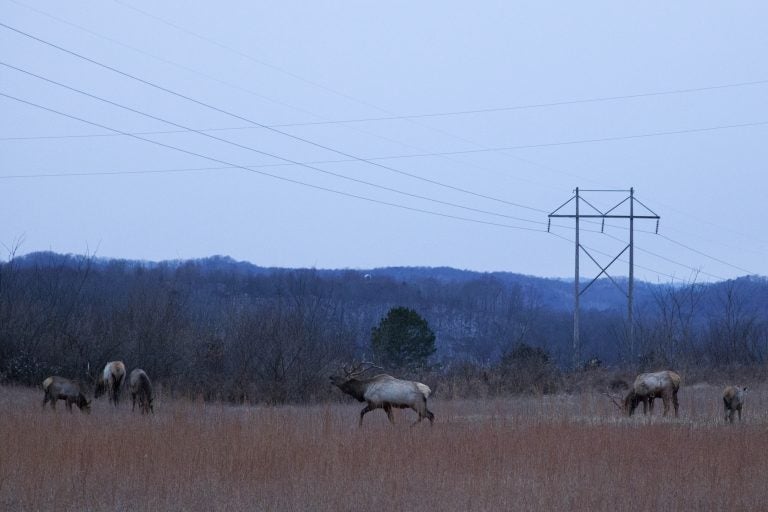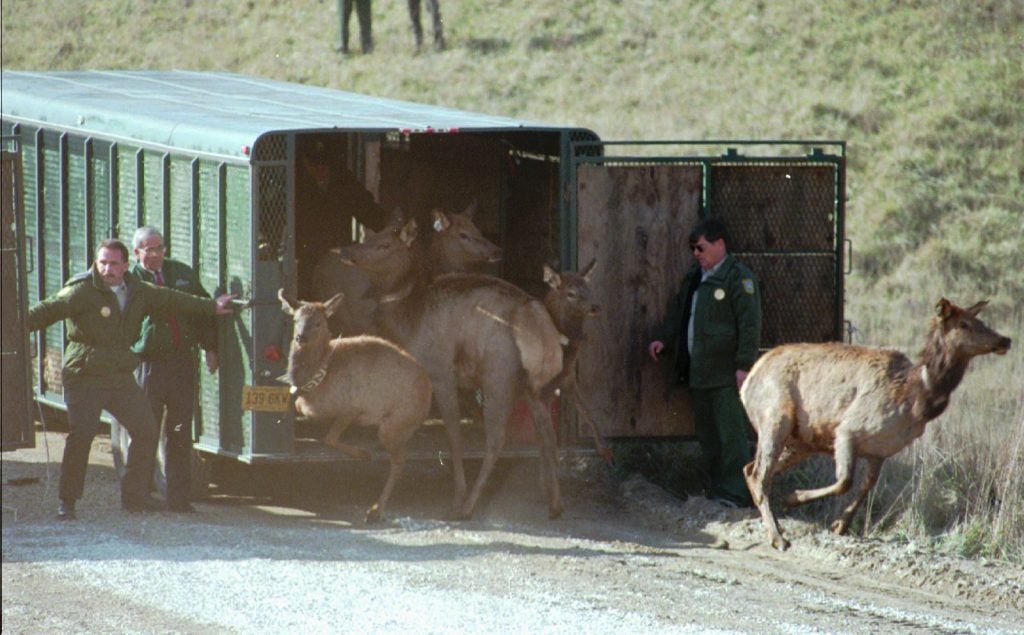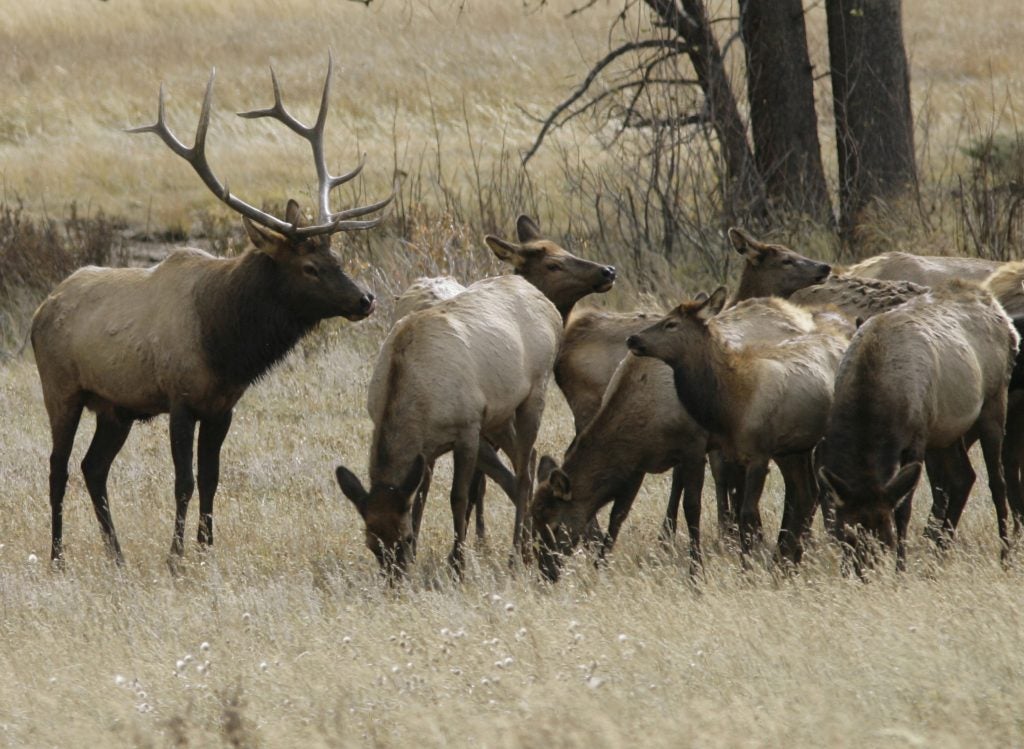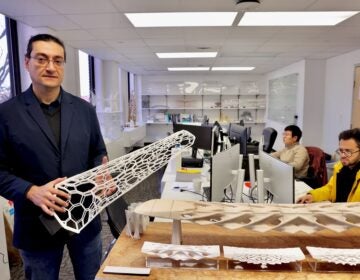Returning wild animals to wild-ish places
We reintroduce animals to their native habitat as part of an impulse to re-create “wilderness” — a place untouched by man. The result is more like the feeling of wilderness.
Listen 10:37
Elk graze at dawn on reclaimed mine land in Kentucky's designated elk zone. The animals were reintroduced to the state in 1997 and have flourished. (Irina Zhorov/The Pulse)
In 1997, thousands of school children gathered in Eastern Kentucky to watch as the governor unlatched the gates of a cattle trailer and released seven elk into the wild.

The animals had been caught in Kansas and trucked across the country. They darted out, their hoofs banging against the metal trailer, then paused in the tall grass, regal and attentive.
Over the next five years 1,500 elk were shipped in from six states in the West, and given a new home here, in a designated managed elk zone. Like other animals — white-tailed deer, wild turkeys, wolves — elk are being reintroduced to places where they once roamed.
10 million strong
Elk used to live throughout most of the United States.
When Europeans started coming across the continent they destroyed and fragmented wildlife habitat. They also hunted. Lots. Tom Toman, director of science and planning for the Rocky Mountain Elk Foundation, says by the late 1800s/early 1900s, we had gone from an estimated 10 million elk in North America to fewer than 100,000.

But for about a century, people have been trying to atone for the decimation by protecting remaining wild habitats and bringing elk back to places they once lived. The early reintroduction attempts were led by hunting groups and largely failed. But these efforts have intensified in the past few decades, largely with support from the Elk Foundation.
Today, Kentucky is one of about a dozen states east of the Rocky Mountains where the elk have been returned.
But when animals are reintroduced, what results is not necessarily wilderness as we’ve come to define it — a place untouched by man. Instead, it’s more like the feeling of wilderness.
“I think it is people trying to get back to as close as possible as what the wildlife and natural history of their particular state really is,” Toman said.
Kentucky elk
I meet up with naturalist Trinity Shepherd on a still-dark winter morning in Eastern Kentucky. He steers his van to where he thinks we can spot some elk.

“Keep your fingers crossed that they’re out this morning.” He speaks quietly, as if the elk can hear him. “They may have slept in.”
But no, they’re up early. As the morning light turns mauve, we come upon a herd.
They munch grass along the road. It’s a few dozen cows and calves, with just a handful of bulls, their brown necks and cream-colored bodies still as we pass. Another car is parked nearby, its passengers watching.
“Since I quit work, I’m over here every morning,” Debra Prater said. “I just drive from point A to point B and just take pictures of them.”
She loves all wildlife — coyotes, deer, owls — but the elk are especially photogenic.
“They’re so majestic, especially the bulls. I got hundreds of pictures of the elk.”
When Prater leaves to take her photos, Shepherd says that a couple of decades ago it was a good day if you spotted a regular old deer or found a turkey feather. The change makes his imagination soar.
“I’ve always tried to imagine myself as Daniel Boone over the Cumberland Gap … over into Kentucky looking around at this rugged wilderness,” Shepherd said.
Wild-ish
If you don’t look past the elk, it all feels kind of natural, but actually Shepherd and I are parked in an industrial park. The land under us was mined by mountaintop removal, where instead of going underground, coal companies razed whole mountains to get at the valuable seams of coal. When companies finished mining, they literally reshaped the landscape. Where once stood steep, craggy mountains with swampy hollows, now roll gentle hills.
“Those lands provide open grazing areas for elk. And of course, these animals being grazers like they are, they need a lot of open land to be able to do that. And that’s what reclaimed surface mining lands provide,” Shepherd said.
In Eastern Kentucky, about 7 percent of the 4-million-acre elk zone are grassy plots. Trinity says without the reclaimed mine lands, there’d be no place for the elk in Kentucky’s modern landscape. Shepherd says they used to live in swampy lowlands, but those places don’t really exist in the state anymore.
“What’s here is here. We can’t jump in a [time] travel machine, go back and change whatever. We’re here today at the industrial park and as you look around, you see a lot of concrete, blacktop, steel, metal, whatever. You don’t think of this as a wilderness. It is an environment. But you don’t think of this as wilderness.”
Other parts of the elk zone are more remote, more wild. But for this habitat to support elk, much of it needs people to manage it. That can include mowing meadows, so forest doesn’t sprout up, and planting diverse grasses like clover and orchard grass. The state thins forests and does controlled burns, something once done by Native Americans, some think. It’s a lot of work for a wild animal.
The elk seem to appreciate it. There are now about 10,000 of them in Kentucky.
Works for people
Elk eat a lot of grass and can be disruptive in agricultural areas. There have been conflicts between elk and farmers in areas where they had to share land. So social acceptance of the animals is important. In other words, Jeff Larkin, a biologist who studied the Kentucky elk initiative, says reintroductions also need to work for people.
“What I mean by that is if an individual takes a hike on a late September day, they will have that sense of being in a wild place, right? Probably much more wilder than where they live,” he said. “And I would argue that the sense of wilderness would be greatly enhanced by that person experiencing, you know, the sudden booming of a bugling bull elk as he watches over his harem.”
That experience could make people care about conservation — and preserving truly untrammeled wilderness.
“And in that sense, the return of a species to a landscape is perhaps more important than the ecological role that it plays in preserving — or, if we want to say — recreating some sense of wild places.”
WHYY is your source for fact-based, in-depth journalism and information. As a nonprofit organization, we rely on financial support from readers like you. Please give today.






